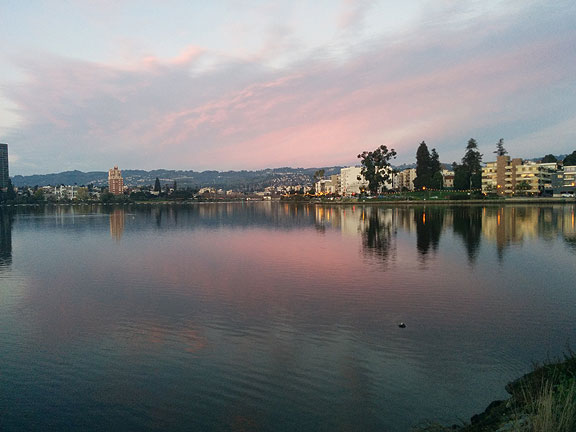
Walking around Lake Merritt on December 7, the light was just gorgeous… epicenter of gentrification and protest during these years, and it will continue to be for some time I’m sure.
Rage and patience, despair and exaggerated confidence—emotions that have been swirling around lately. The demonstrations, blockades, and protests of many varieties have come as an inspiration and their resilience and fortitude is absolutely surprising. Something new might be happening, something we’ve dreamed of and hoped for, for a long time. I’ve seen tweets and facebook posts claiming an insurrection is underway but that seems grandly overstated, the hubris of youth at best. On the other hand, the steady unrelenting pressure in the streets in Ferguson, New York, Oakland, San Francisco, Milwaukee, Chicago, Los Angeles and other places, combined with the recognition that the protagonists are not the same old faces (even if some of them—us—are out there too!), is worthy of close attention and critical support. More on this in a minute.
It’s the end of another year. I found myself writing a lot less this past year. No book project underway (though that’s about to change), blogging once a month at best. Instead of thrusting my own views onto the world (something I’ve done plenty of in my life, after all!) I seem to have taken a break. I didn’t decide to do it, but instead of opining on everything going by, or forcing myself to write something that I didn’t feel particularly inspired to do, I spent a lot of time reading other peoples’ words, mostly books, but plenty of magazines and to a lesser extent, online and electronic writings. I do download or bookmark a lot of articles and even whole publications but I rarely go back and read them because frankly, I like physical books and magazines much more than electronic reading. Partly I had to do some catch-up reading to be able to be a good teacher in the classes I taught at the SF Art Institute, and partly I have a tendency to accumulate books I want to read and haven’t made enough time for them. So I was able to plow through dozens of fantastic books this year, all of which have helped deepen my growing historical knowledge about San Francisco and California, as well as filling in important gaps in my grasp of 19th century history.
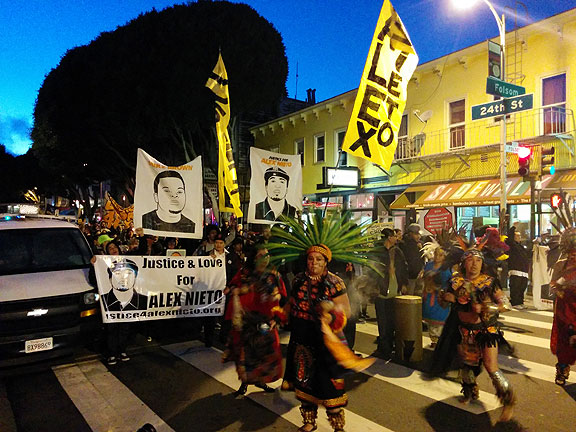
Marchers pause at 24th and Folsom during the longest night of the year, celebrating a Posada for Alex Nieto.
Anyway, I have also been in a small, background support role to Adriana’s amazing work on the Alex Nieto case. After his murder by local police on March 21, 2014 she threw herself into working with the family and friends and that has been absorbing much time and attention around our house. She’s determined to shape the narrative, which has put her in the role of the tortoise vis-à-vis the hare known as the San Francisco Police Department. When they shoot someone, their modus operandi (apparently this is the model used across the U.S., probably developed by the FBI with major input from the politicized cops and ex-cops who run police unions) is to assassinate the character of the victim within hours of the shooting. Instant criminalization irrespective of any facts is an essential component of their strategy, and its purpose is to put up a cloud of doubt over the circumstances under which the victim was killed. Then, having “established” by leaking false or irrelevant information that the person shot by police somehow caused it themselves, either because of prior interaction with law enforcement or all too often because of documented mental health issues, the police can claim that they were endangered and had to use deadly force. They did this to Alex Nieto—you can read how they took 18 hours to inform the family they had killed Alex, how they bluffed their way into their home and tried to find “evidence” to use before telling what happened, and so on. It’s amazing that this case doesn’t already have the kind of national profile that Michael Brown and Eric Garner and some others are getting. But it may get there yet, since anyone familiar with the facts can see that Greg Suhr, the San Francisco police chief, is probably personally involved in obstruction of justice and a cover-up, and the whole department is doing whatever it can to delay, obfuscate, and prevent a proper investigation from taking place.
So the police leaks in the first 24 hours tried to establish Alex as a mentally unstable, armed and dangerous gang member. When in the following days family and friends brought forth the facts that he was a practicing Buddhist, a pacifist, a student of criminal justice at City College who had volunteered with the probation department, and was widely known as a friendly, engaged, and thoughtful young man, the story the police had leaked continued to dominate the narrative. But Adriana and others in the Justice4Alex Nieto coalition have done a great job of persistently keeping the campaign going, regularly staging peaceful demonstrations to highlight the facts of the case (which have gotten very little attention from the press until recently—presumably because there has been no violence or property destruction).
But slowly and steadily the case is drawing more and more attention. In recent Bay Area demonstrations, Alex Nieto’s name and face have been prominent during BlackLivesMatter and other protests against police impunity. Adriana organized an amazing march and Posada (with key help from several other coalition members) for Alex Nieto on the longest night of the year, December 21, and invited families of several other victims of police murder: O’Shaine Evans, Errol Chang, Andy Lopez, Yanira Serrano—the list just keeps growing. Earlier cases such as Idris Stelley, Kenneth Harding, Jr., and of course the better known Oscar Grant, all contribute to a growing anger and sense that the police kill with impunity on a regular basis, and for very little provocation—often because the victim is behaving “erratically” according to the police. Later it is discovered that the person, whether Idris Stelley, Errol Chang, or Yanira Serrano, were in fact having episodes of bipolar paranoia, something that warranted a mental health response rather than a violent police response.
Taking stock in the moment, I’m very proud of Adriana’s great work keeping the Alex Nieto case in the public eye when the police strategy has depended on it fading away. And combining the close-up look I have at this case with the broad eruption of protest and dissent nationwide, I am truly hopeful that something is brewing that won’t be easily dismissed. This is a movement of tortoises, taking the steady, plodding steps to keep this going, embodying what I always like to call radical patience. Not a patience of waiting or being passive, but a patience that understands this is a long effort that may not produce results as soon as anyone would prefer, but the effort must continue regardless. It’s driven by rage, a perfectly reasonable rage at the racism and impunity and militarization that defines most police departments.
I’m particularly impressed by the various freeway occupations that took place over a few weeks in many major cities. It seems the long missing awareness of the vulnerable arteries of modern city life has fully emerged, and now thousands of people have learned how to block them. Modern life depends on the constant flow of private citizens in private cars, not unlike our body’s dependence on blood flowing to and from the heart at all times. When freeway circulation is stopped by a social protest, it is a powerful point of leverage. Granted, the media will portray the demonstrators as unreasonable, as sabotaging their own cause by delaying and angering thousands of people caught in the ensuing traffic jams. But that’s not so different than the abuse heaped upon sitdown strikers in the 1930s who pioneered a new kind of workplace occupation that led to the rapid establishment of industrial unions (it’s another problem to go in to the contradictions and weaknesses of the union structure, which I’ll leave aside for now). It’s also very similar to the disdain and dismissive anger directed at Critical Mass rides over the years—but look how many more people ride bicycles everyday now than were when Critical Mass was starting in 1992, not just in San Francisco but in cities across the country and the world.
Unlike the Occupy movement, which created sedentary sites that ultimately could not be defended from heavily armed police attack, this new wave of protest involves a lot of mobile actions, hit-and-run tactics, as well as some impressively planned and disciplined aggressive nonviolent direct actions (specifically the BART blockade on Black Friday, and the shutdown of the Oakland Police Department). A lot of attention gets paid to the broken windows and trash fires that have happened during some of these evening perambulations through the streets, but the widespread forcefulness of the protest, usually without those distractions in most places, is what is most inspiring.
Of course there’s been a fair amount of “proletarian shopping” too, especially as the holidays were approaching and the opportunity to loot a mobile phone store or an electronics shop was right in front of people. Hardly seems surprising or even worth worrying about—what does anyone expect in a society where the wealthy have concentrated so much wealth in their hands in the past two decades while people at the bottom of the economic ladder have actually grown poorer? The meaningful looting that has happened in this society is the billions being stolen everyday by the kleptocratic elite that lines their pockets in all sorts of direct and indirect ways at the expense of the public. Anyone who has examined the wealth distribution statistics lately can only be enraged by the impunity enjoyed by the bankers, the military contractors, and their political front men and women. Redistribution in the other direction of our social wealth is long overdue and we can hardly begrudge those who have decided to take their limited opportunities to get on with it.
Then there’s the looting of the planet that fossil fuel use represents. The climate movement also keeps plodding alongside the rise of alternative energy sources. There are some good critiques of the notion that we can just replace all that cheap oil that underpins transportation and food production with solar and wind—we will almost certainly need to radically reduce how much energy we use going forward. But the status quo is untenable and unsustainable. It seems everyone knows it, whether combating the historically rooted structural racism that still leads to horrendous routine state-sanctioned murder, disproportionately of black and brown people, or those who are focused on blocking fracking (a great success, at least for now, in New York state), tar sands oil pipelines, or just campaigning to leave the oil in the soil.
It’s easy to despair when the propagandistic so-called “news” reinforces so much of our isolation while making the way things are seem so inevitable and timeless. But history says otherwise. Things are changing fast now, and there is a real opportunity to forge a very different way to live from the final throes of the exploitative and barbaric rule we’ve been under for more than a century.
My favorite difficult challenge of the moment, beyond all the obvious ones so many people are trying to come to grips with already, is how do we scale up from the daily cooperation and mutual aid that makes life possible? How do we imagine complex urban systems of water, food, transportation, communication, electricity, etc., being maintained and even expanded in the context of radically egalitarian social movements with a commitment to ecological sanity? In other words, how do we go about reproducing life in all its complexity and interdependence while eliminating the stupidities enforced by markets and concentrated wealth calling the shots? I’m heartened by the many forms social opposition and social creativity are taking right now, but I’m also daunted by the limits of these efforts. Most people are understandably reluctant to even address the larger issue of how we go about reproducing a life worth living in ways that are vastly better than how we do it now? What does “better” mean in this context? My “easy answer” is less work, more enjoyment, more fairness, restoration of natural systems and a commitment to sensitive ecological balance regarding resources, technologies, and all forms of life. Which technologies are going to be useful going forward? How do the imperatives of their use impose social structures that are incompatible with newly egalitarian social practices? Can they be redesigned to reinforce different ways living instead of keeping us trapped in old paradigms? These are some of the questions that haunt me, and I hope to do some serious investigative and historical writing to shed light on them in the coming year(s)…
Meanwhile, the rage is growing, and patience—the radical kind—is what will keep the pressure on and the movement growing and innovating. The coming year will be interesting indeed!

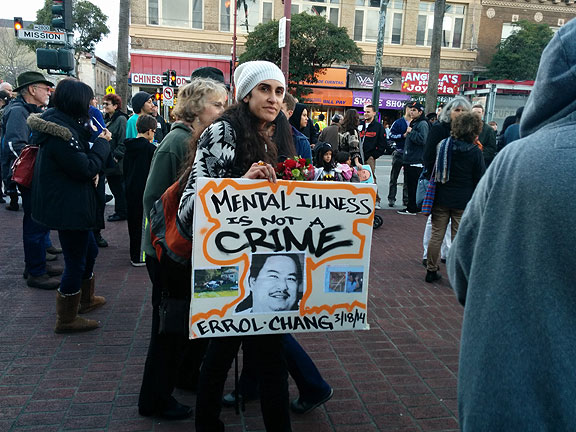
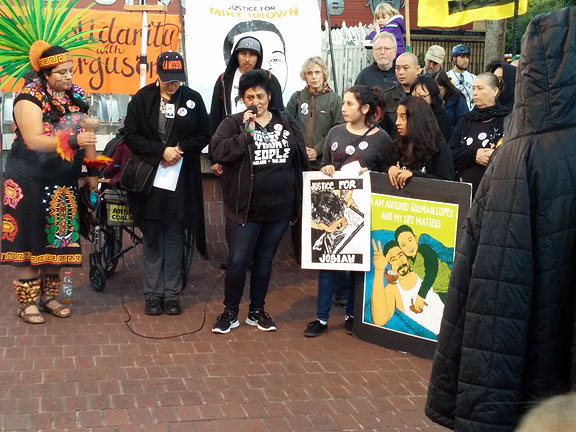
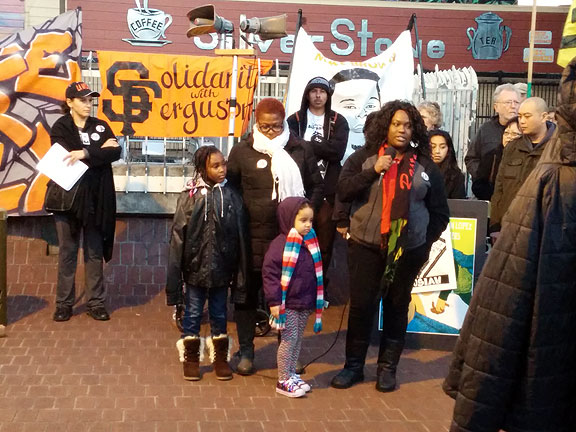
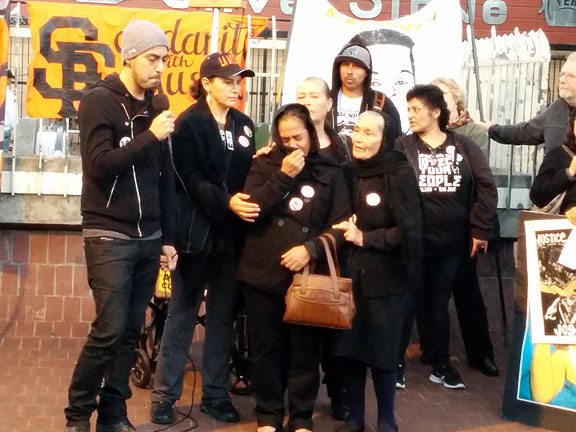
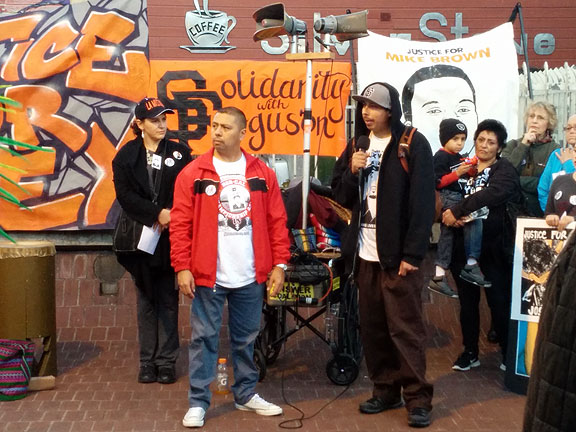
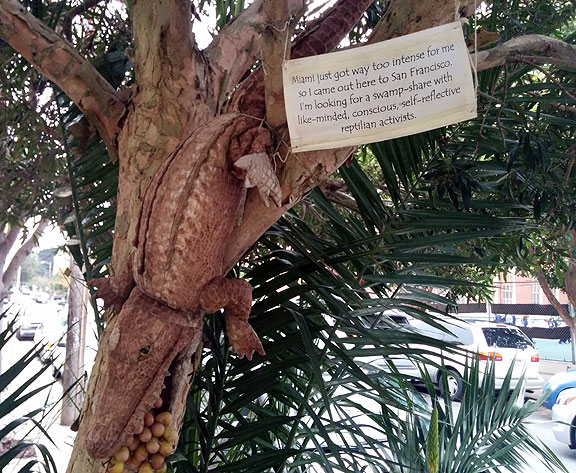












Though yours is always a welcome voice, and there is some good old-fashioned punditry here, the end of the year has occasioned some ferocious wish-blasting from the veteranos of the left – the Empire is crumbling, the resistance is mounting, another better world is about to happen!
Just as there is obligatory Times Square corporate revelry, this is the annual imaginative toast of the better-worlders – but I won’t be raising a glass along with the Nowtopians – sorry, there is only more data and evidence for exploitation and devastation, not “restoration” nor “vastly better.” Cheers anyway.
Rage is the right mood –
Rage is tied to justice, the appropriate demand, via collective action in social space and the public policy arena (as opposed to the private and individual compassions of love).
Rage drives action to demand justice.
Rage, more than love, needs to shape our efforts.
And I too was impressed by the tactics of blocking traffic.
The revolution will not be done under a permit!
Hahahaha!
Happy New Year Nowtopian! You move my spirt and challenge my mind!
My only quibble is that for the tortoises (that is, the families and close friends of someone killed by police) the drive is love, not only, nor even mainly rage. Rage is not as sustainable as love. As an organizer for http://www.justice4alexnieto.org, I cannot claim either as a primary driving force for accompanying his family, but rather I am driven by dogged loyalty to those who move tirelessly through loss and anger, because of their love for the person stolen from them. … And our medium is primarily storytelling, because the story of the stolen one and those victimized by his or her killing must be told over and over again to combat the lies and half-truths put out by police, which is one of the points you make…